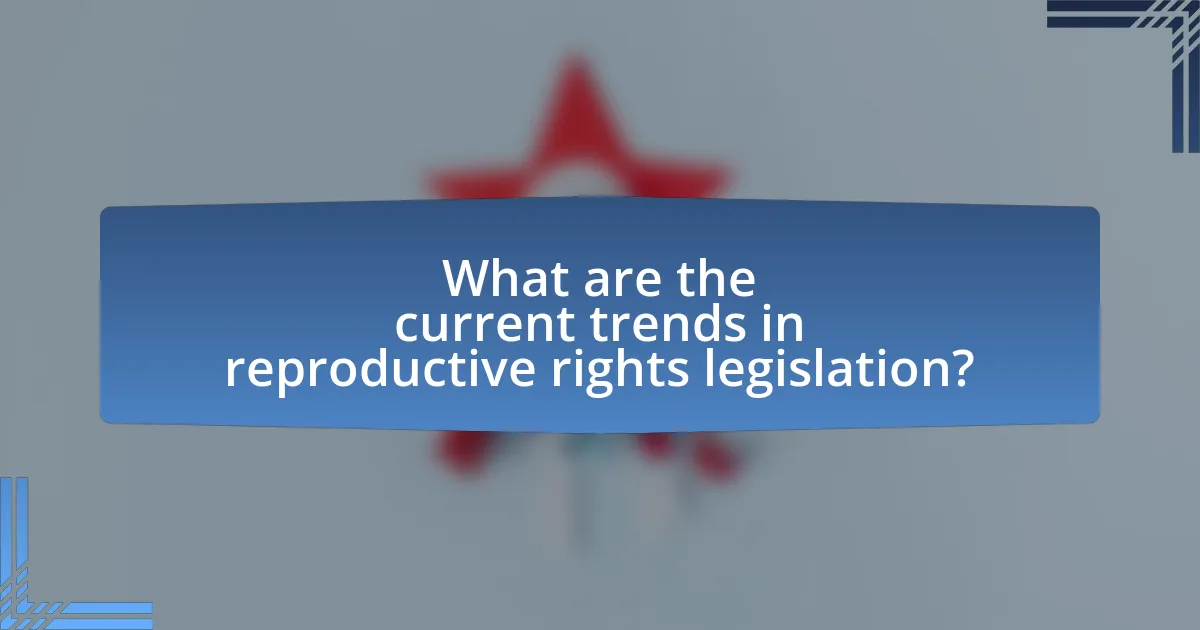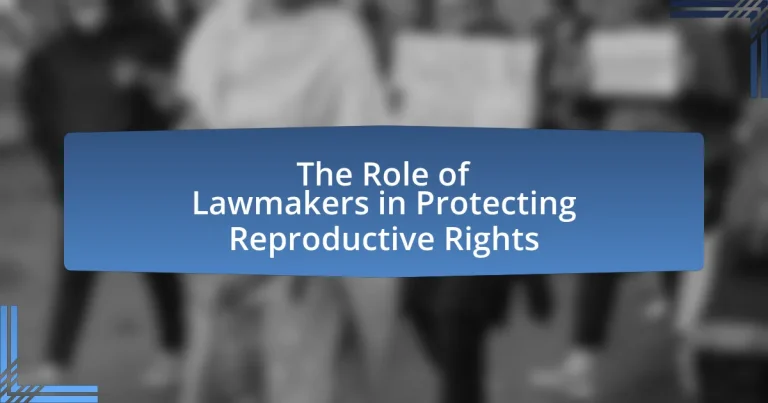The article focuses on the critical role of lawmakers in protecting reproductive rights, emphasizing their responsibility to create, amend, and enforce legislation that ensures access to reproductive health services, including contraception and abortion. It outlines how lawmakers influence reproductive rights through legislative actions, public advocacy, and engagement with constituents, while also addressing the challenges they face, such as political polarization and varying public opinions. Key legislative measures, the impact of legal precedents, and the importance of public sentiment in shaping reproductive rights laws are discussed, alongside strategies for effective advocacy and collaboration with interest groups. The article highlights the implications of reproductive rights on public health and gender equality, underscoring the necessity for lawmakers to adopt evidence-based policies and engage in ongoing education to enhance their effectiveness in this area.

What is the Role of Lawmakers in Protecting Reproductive Rights?
Lawmaker’s primary role in protecting reproductive rights involves creating, amending, and enforcing legislation that safeguards access to reproductive health services. They are responsible for drafting laws that ensure individuals have the right to make decisions about their reproductive health, including access to contraception and abortion services. For instance, the landmark Supreme Court case Roe v. Wade in 1973 established a woman’s legal right to abortion, which lawmakers have since sought to protect or restrict through various state and federal laws. Additionally, lawmakers can advocate for policies that promote comprehensive sex education and funding for reproductive health services, thereby reinforcing the protection of reproductive rights.
How do lawmakers influence reproductive rights legislation?
Lawmakers influence reproductive rights legislation by crafting, amending, and voting on laws that regulate access to reproductive health services. For instance, in the United States, state legislatures have enacted various laws that either expand or restrict access to abortion and contraception, reflecting the political ideologies of the lawmakers in power. According to the Guttmacher Institute, as of 2021, 19 states enacted 106 abortion restrictions, demonstrating how legislative actions directly impact reproductive rights. Additionally, lawmakers can influence public policy through committee hearings, public statements, and advocacy efforts, shaping the national conversation around reproductive health issues.
What are the key legislative measures related to reproductive rights?
Key legislative measures related to reproductive rights include the Roe v. Wade decision, which established a woman’s legal right to abortion in the United States in 1973, and the Affordable Care Act, which expanded access to contraceptive services. Additionally, the Title X Family Planning Program provides federal funding for family planning services, ensuring access to reproductive health care for low-income individuals. The Women’s Health Protection Act aims to protect the right to access abortion services at the federal level. These measures collectively shape the legal landscape surrounding reproductive rights, influencing access and protections for individuals seeking reproductive health care.
How do lawmakers balance public opinion and reproductive rights?
Lawmakers balance public opinion and reproductive rights by engaging in legislative processes that reflect constituents’ views while also adhering to legal precedents and human rights standards. For instance, they often conduct surveys and polls to gauge public sentiment on reproductive issues, such as abortion access, and use this data to inform their policy decisions. Additionally, lawmakers consider landmark rulings like Roe v. Wade, which established a woman’s legal right to choose, ensuring that any legislation aligns with constitutional protections. This dual approach allows them to navigate the complexities of public opinion while safeguarding reproductive rights, as evidenced by the ongoing debates and legislative actions surrounding reproductive health laws across various states.
Why is the protection of reproductive rights important?
The protection of reproductive rights is important because it ensures individuals have the autonomy to make informed decisions about their own bodies and reproductive health. This autonomy is fundamental to personal freedom and is supported by various international human rights frameworks, such as the Universal Declaration of Human Rights, which emphasizes the right to privacy and family life. Furthermore, studies indicate that access to reproductive health services, including contraception and safe abortion, significantly reduces maternal mortality rates; for instance, the World Health Organization reports that access to safe abortion can prevent up to 47,000 maternal deaths annually. Thus, safeguarding reproductive rights is essential for promoting health, equality, and human dignity.
What impact do reproductive rights have on public health?
Reproductive rights significantly impact public health by ensuring access to safe and legal reproductive healthcare services, which reduces maternal mortality and morbidity rates. Studies show that countries with comprehensive reproductive rights experience lower rates of unintended pregnancies and unsafe abortions, leading to improved overall health outcomes. For instance, the World Health Organization reports that access to contraception can reduce maternal deaths by up to 30%. Furthermore, reproductive rights empower individuals to make informed choices about their health, contributing to better mental and physical well-being.
How do reproductive rights relate to gender equality?
Reproductive rights are fundamental to achieving gender equality because they empower individuals to make autonomous decisions about their bodies and reproductive health. When women have access to reproductive healthcare, including contraception and safe abortion services, they can participate more fully in society, pursue education and careers, and make informed choices about family planning. According to the World Health Organization, access to reproductive health services is essential for women’s health and well-being, which directly impacts their social and economic status. Furthermore, studies show that countries with higher levels of reproductive rights tend to have greater gender equality indicators, such as women’s participation in the workforce and political representation. Thus, reproductive rights are intrinsically linked to the broader framework of gender equality, as they enable women to exercise their rights and freedoms.
What challenges do lawmakers face in protecting reproductive rights?
Lawmakers face significant challenges in protecting reproductive rights, primarily due to political polarization and varying public opinions. The contentious nature of reproductive rights often leads to legislative gridlock, as differing ideologies between parties create obstacles in passing protective measures. For instance, in the United States, the Supreme Court’s decision in 1973’s Roe v. Wade established a constitutional right to abortion, yet subsequent state-level restrictions have intensified debates, resulting in a patchwork of laws that complicate access. Additionally, lawmakers must navigate lobbying efforts from both pro-choice and anti-abortion groups, which can influence legislation and public sentiment. These factors contribute to an environment where enacting comprehensive reproductive rights protections becomes increasingly difficult.
What role do interest groups play in shaping reproductive rights legislation?
Interest groups significantly influence reproductive rights legislation by advocating for specific policies, mobilizing public opinion, and lobbying lawmakers. These organizations, such as Planned Parenthood and the National Right to Life Committee, engage in campaigns to raise awareness about reproductive issues, thereby shaping the political landscape. For instance, according to a 2020 report by the Guttmacher Institute, states with active interest groups advocating for reproductive rights saw a higher likelihood of passing supportive legislation. This demonstrates that interest groups not only provide resources and information to lawmakers but also create a framework within which reproductive rights are debated and legislated.
How do legal precedents affect lawmakers’ decisions on reproductive rights?
Legal precedents significantly influence lawmakers’ decisions on reproductive rights by establishing binding interpretations of the law that guide legislative actions. For instance, the Supreme Court’s decision in Roe v. Wade (1973) set a legal framework that recognized a woman’s right to choose an abortion, compelling lawmakers to consider this precedent when drafting or amending related legislation. Additionally, subsequent cases like Planned Parenthood v. Casey (1992) reaffirmed the core principles of Roe, further shaping the legislative landscape by limiting the extent to which states can impose restrictions on abortion access. These precedents create a legal environment that lawmakers must navigate, often leading them to align their policies with established judicial interpretations to avoid legal challenges and ensure compliance with constitutional standards.
How can lawmakers effectively advocate for reproductive rights?
Lawmakers can effectively advocate for reproductive rights by introducing and supporting legislation that protects access to reproductive healthcare services. For instance, they can propose bills that safeguard the right to abortion, ensure comprehensive sex education, and expand access to contraceptives. Evidence from the Guttmacher Institute shows that states with supportive reproductive health policies experience lower rates of unintended pregnancies and better maternal health outcomes. By actively engaging with constituents, lawmakers can also raise awareness about reproductive rights issues, mobilizing public support to influence policy changes.
What strategies can lawmakers use to engage constituents on reproductive rights?
Lawmakers can engage constituents on reproductive rights by implementing community outreach programs, hosting town hall meetings, and utilizing social media platforms for direct communication. Community outreach programs allow lawmakers to connect with constituents in their local areas, fostering dialogue and understanding of reproductive rights issues. Town hall meetings provide a platform for constituents to voice their concerns and ask questions, creating an interactive environment that encourages civic participation. Additionally, social media platforms enable lawmakers to disseminate information quickly, respond to constituents’ inquiries, and mobilize support for reproductive rights initiatives. These strategies have been shown to increase public awareness and involvement, as evidenced by studies indicating that direct engagement leads to higher levels of constituent activism and advocacy on reproductive issues.

What are the current trends in reproductive rights legislation?
Current trends in reproductive rights legislation include increased restrictions on abortion access in various states, alongside efforts to expand contraceptive access and comprehensive sex education. For instance, following the Supreme Court’s decision in Dobbs v. Jackson Women’s Health Organization in 2022, numerous states enacted laws that significantly limit or ban abortions, reflecting a shift towards more conservative reproductive policies. Conversely, some states have introduced legislation aimed at protecting and expanding access to reproductive health services, including measures to ensure insurance coverage for contraceptives and support for reproductive health education. These trends illustrate a polarized landscape where legislative actions are heavily influenced by political ideologies and public opinion on reproductive rights.
How have recent court rulings influenced reproductive rights laws?
Recent court rulings have significantly influenced reproductive rights laws by either expanding or restricting access to abortion and related services. For instance, the U.S. Supreme Court’s decision in Dobbs v. Jackson Women’s Health Organization in 2022 overturned Roe v. Wade, effectively allowing states to impose stricter abortion regulations, which has led to numerous states enacting laws that severely limit or ban abortions altogether. This ruling has prompted a wave of legislative changes at the state level, with some states enacting protective measures to safeguard reproductive rights, while others have moved to restrict them, reflecting a polarized legal landscape.
What are the implications of landmark cases on reproductive rights?
Landmark cases on reproductive rights significantly shape legal precedents and societal norms regarding access to reproductive healthcare. For instance, the 1973 Supreme Court case Roe v. Wade established a woman’s legal right to choose an abortion, influencing subsequent legislation and court rulings across the United States. This case set a framework for reproductive rights that has been referenced in numerous legal challenges and discussions, reinforcing the importance of privacy and bodily autonomy. Additionally, cases like Planned Parenthood v. Casey in 1992 upheld Roe’s core principles while allowing states to impose certain regulations, demonstrating the ongoing negotiation between state interests and individual rights. These landmark decisions not only affect legal interpretations but also impact public policy, advocacy efforts, and the overall landscape of reproductive health services.
How do state-level laws differ from federal laws regarding reproductive rights?
State-level laws regarding reproductive rights often differ significantly from federal laws by allowing for greater restrictions or protections based on local governance. For example, while federal law, particularly the landmark Supreme Court decision in Roe v. Wade (1973), established a woman’s right to choose an abortion, many states have enacted laws that impose waiting periods, parental consent requirements, and limitations on when abortions can be performed. As of 2023, some states have enacted near-total bans on abortion, while others have expanded access, reflecting a patchwork of regulations that diverge from federal standards. This variation illustrates how state lawmakers can influence reproductive rights in ways that may either align with or contradict federal protections.
What role does public opinion play in shaping reproductive rights legislation?
Public opinion significantly influences the development of reproductive rights legislation by shaping lawmakers’ priorities and actions. When a majority of the public supports reproductive rights, legislators are more likely to propose and enact laws that protect these rights, as seen in the widespread support for Roe v. Wade in the 1970s, which led to the legalization of abortion in many states. Conversely, when public sentiment shifts against reproductive rights, as evidenced by recent polling trends in various states, lawmakers may introduce restrictive measures to align with constituents’ views. This dynamic illustrates that public opinion serves as a critical barometer for legislators, guiding their decisions and legislative agendas on reproductive rights.
How do lawmakers gauge public sentiment on reproductive issues?
Lawmakers gauge public sentiment on reproductive issues primarily through opinion polls and surveys. These tools provide quantitative data reflecting constituents’ views, allowing legislators to understand the prevailing attitudes towards reproductive rights. For instance, a 2022 Gallup poll indicated that 55% of Americans identified as pro-choice, illustrating a significant public stance that lawmakers can consider when formulating policies. Additionally, lawmakers often analyze social media trends and public comments during town hall meetings to capture real-time sentiment and concerns regarding reproductive issues.
What impact does social media have on reproductive rights advocacy?
Social media significantly enhances reproductive rights advocacy by facilitating widespread communication and mobilization among supporters. Platforms like Twitter and Facebook allow activists to share information rapidly, organize events, and raise awareness about reproductive health issues, leading to increased public engagement. For instance, the #ShoutYourAbortion campaign on social media has empowered individuals to share their abortion experiences, challenging stigma and fostering community support. Additionally, studies indicate that social media campaigns can influence public opinion and policy discussions, as seen in the increased visibility of reproductive rights issues during legislative debates.
What are the implications of international reproductive rights policies?
International reproductive rights policies significantly influence access to healthcare, gender equality, and population control. These policies shape national laws and practices, often determining the availability of services such as contraception and safe abortion. For instance, countries that adopt comprehensive reproductive rights frameworks tend to report lower maternal mortality rates and improved health outcomes for women, as evidenced by data from the World Health Organization, which indicates that access to reproductive health services can reduce maternal deaths by up to 30%. Furthermore, these policies can empower women by enhancing their autonomy and decision-making capabilities, contributing to broader social and economic development.
How do global trends in reproductive rights affect local legislation?
Global trends in reproductive rights significantly influence local legislation by creating a framework that lawmakers often reference when drafting or amending laws. For instance, international agreements such as the Convention on the Elimination of All Forms of Discrimination Against Women (CEDAW) encourage countries to align their laws with global standards on reproductive health and rights. This alignment can lead to the introduction of more progressive policies at the local level, as seen in countries that have adopted more liberal abortion laws following global advocacy campaigns. Additionally, public opinion in many regions is increasingly shaped by global discourse, prompting local lawmakers to respond to constituents’ demands for improved reproductive rights, thereby leading to legislative changes that reflect these global trends.
What lessons can lawmakers learn from other countries’ approaches to reproductive rights?
Lawmakers can learn that comprehensive reproductive rights frameworks, such as those in countries like Sweden and the Netherlands, lead to better health outcomes and greater gender equality. For instance, Sweden’s approach includes universal access to contraception and abortion services, resulting in lower rates of unintended pregnancies and maternal mortality. Additionally, the Netherlands emphasizes sex education and preventive care, which has contributed to one of the lowest abortion rates in Europe. These examples demonstrate that integrating reproductive health services into broader healthcare systems and prioritizing education can enhance reproductive rights and public health.

How can lawmakers improve their effectiveness in protecting reproductive rights?
Lawmakers can improve their effectiveness in protecting reproductive rights by enacting comprehensive legislation that safeguards access to reproductive health services. This includes implementing laws that ensure affordable contraception, protect the right to abortion, and provide comprehensive sex education. For instance, states that have passed laws to expand Medicaid coverage for reproductive health services have seen increased access for low-income individuals, as evidenced by a study from the Guttmacher Institute, which found that expanding Medicaid led to a 25% increase in contraceptive use among women in those states. Additionally, lawmakers should prioritize the appointment of judges who uphold reproductive rights, as judicial decisions significantly impact the enforcement of these laws. By focusing on these strategies, lawmakers can create a more supportive legal framework for reproductive rights.
What best practices should lawmakers adopt in reproductive rights advocacy?
Lawmakers should adopt evidence-based policies that prioritize women’s health and autonomy in reproductive rights advocacy. This includes ensuring access to comprehensive reproductive health services, such as contraception and safe abortion, which are supported by research indicating that access to these services reduces maternal mortality rates and improves overall public health outcomes. Additionally, lawmakers should engage with stakeholders, including healthcare professionals and advocacy groups, to create informed legislation that reflects the needs and rights of individuals. Data from the Guttmacher Institute shows that states with supportive reproductive health policies experience better health outcomes for women and families. By focusing on these best practices, lawmakers can effectively advocate for reproductive rights and contribute to a more equitable healthcare system.
How can collaboration with advocacy groups enhance legislative efforts?
Collaboration with advocacy groups can enhance legislative efforts by providing lawmakers with critical insights, mobilizing public support, and ensuring that diverse perspectives are represented in policy discussions. Advocacy groups often possess specialized knowledge and data that can inform legislative proposals, making them more effective and relevant. For instance, research from the Guttmacher Institute indicates that states with strong advocacy networks are more likely to enact comprehensive reproductive health policies. Additionally, these groups can galvanize grassroots movements, increasing voter engagement and pressure on legislators to act in favor of reproductive rights. This synergy between lawmakers and advocacy organizations ultimately leads to more informed, responsive, and impactful legislation.
What role does education play in informing lawmakers about reproductive rights?
Education plays a crucial role in informing lawmakers about reproductive rights by providing them with evidence-based information and insights into the implications of policies. Through comprehensive education, lawmakers gain an understanding of the medical, social, and economic aspects of reproductive health, which enables them to make informed decisions. For instance, studies have shown that lawmakers who receive training on reproductive health issues are more likely to support policies that protect reproductive rights, as evidenced by the increased legislative support for reproductive health initiatives in states with educational programs for legislators. This informed perspective is essential for creating laws that reflect the needs and rights of individuals regarding reproductive health.
What resources are available for lawmakers to support reproductive rights initiatives?
Lawmakers can access various resources to support reproductive rights initiatives, including advocacy organizations, legal frameworks, and research data. Advocacy organizations such as Planned Parenthood and the Guttmacher Institute provide lawmakers with policy recommendations, legal analysis, and grassroots mobilization strategies. Legal frameworks, including the Roe v. Wade decision and subsequent court rulings, offer a foundation for understanding reproductive rights legislation. Additionally, research data from sources like the Centers for Disease Control and Prevention (CDC) and the World Health Organization (WHO) supply lawmakers with statistics on reproductive health trends, informing evidence-based policy decisions.
How can lawmakers access research and data on reproductive health issues?
Lawmakers can access research and data on reproductive health issues through various governmental and non-governmental organizations, academic institutions, and public health agencies. For instance, the Centers for Disease Control and Prevention (CDC) provides comprehensive data on reproductive health through its National Vital Statistics Reports, which include statistics on birth rates, maternal health, and reproductive health outcomes. Additionally, the Guttmacher Institute publishes research and policy analysis on reproductive health issues, offering lawmakers evidence-based insights and data. Accessing these resources enables lawmakers to make informed decisions regarding reproductive rights and health policies.
What training programs exist for lawmakers on reproductive rights advocacy?
Training programs for lawmakers on reproductive rights advocacy include initiatives by organizations such as the Center for American Progress, the National Women’s Law Center, and Planned Parenthood. These programs focus on educating lawmakers about reproductive health policies, legal frameworks, and advocacy strategies. For instance, the Center for American Progress offers workshops that cover the impact of legislation on reproductive rights and provide tools for effective advocacy. The National Women’s Law Center provides resources and training on legal protections for reproductive health, while Planned Parenthood conducts advocacy training sessions that equip lawmakers with the necessary skills to support reproductive rights legislation.
What are the next steps for lawmakers in advancing reproductive rights?
Lawmakers can advance reproductive rights by introducing and supporting legislation that protects access to reproductive health services, including abortion and contraception. This includes drafting bills that safeguard these rights at both state and federal levels, as seen in the introduction of the Women’s Health Protection Act, which aims to codify the right to abortion into federal law. Additionally, lawmakers should engage in public education campaigns to raise awareness about reproductive rights and mobilize constituents to advocate for these issues. Historical context shows that states with proactive reproductive health policies tend to have better health outcomes for women, reinforcing the need for legislative action.


